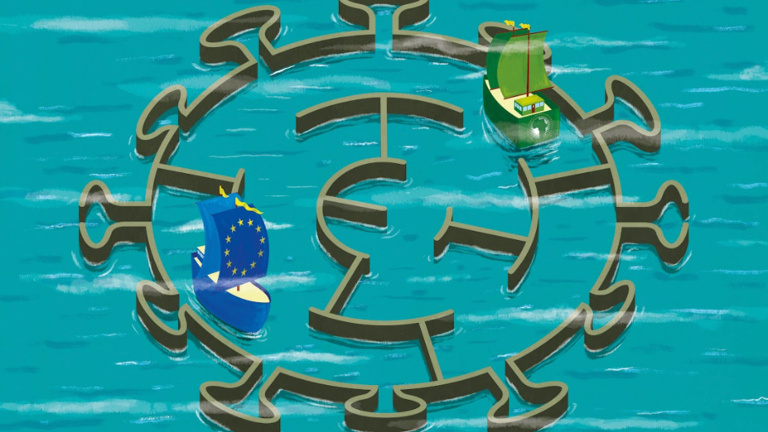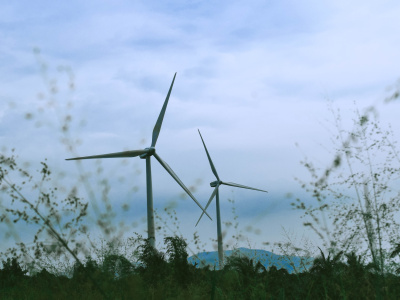
Using the AU-EU partnership to make strides towards a more circular economy on both continents
The circular economy is more than just a pipe dream. It is an essential element of job creation and low-emissions, climate resilient and sustainable development. Intensifying cooperation between African and European actors has great potential to contribute to the circular economy transition.
Turning the tide together
The joint declaration of the last African Union (AU) – European Union (EU) summit in 2017 was clear: leaders on both continents pronounced their commitment to jointly promote responsible and sustainable allocation of public and private capital to the transition to a circular economy. Indeed, the circular economy is considered to have high potential for job creation and low-emissions, climate resilient and sustainable development.
Now, almost three years down the line, the rationale for collaboration in this space has not disappeared. On the contrary, despite the many encouraging initiatives we still live in a world that is only 8.6% circular – and even that marks a deterioration from 2018, when circularity was estimated at 9.1%. Though the widening global ‘circularity gap’ predates the corona crisis, its message is unambiguous: there is work to be done. Food and plastic waste, for example, is still a major concern on both sides of the Mediterranean. Further efforts are needed for the transition to a circular economy, including in the global value chains that connect Africa and the European Union (EU). This means designing waste and pollution out of our economic system, keeping products and materials in use for as long as possible and regenerating natural systems to stay within the boundaries of our planet while satisfying societies’ basic needs.
Intensifying cooperation between the EU and the AU and between the members of both regional communities for more circularity is fully in line with the EU’s Green Deal, its Farm to Fork Strategy and its Circular Economy Action Plan. The Action Plan is quite specific in aspiring for “a stronger partnership with Africa to maximise the benefits of the green transition and the economic opportunities in the circular economy”. It can be no surprise then, that the circular economy is prominent in the EU’s vision for the future Africa-EU partnership, published in March 2020 in preparation for the next AU-EU Summit, now set for 2021, COVID-19 permitting.
While the African side has been less vocal about the centrality of the circular economy in Africa-EU cooperation, it fits with the circular economy paths that various African countries have embarked, such as Ghana, Kenya and South Africa. To take the example of South Africa, the government has the ambition to position the country as a significant actor in the green growth and green development space. South African actors, including those in the business world, increasingly recognise that applying circular economy principles can generate income and create jobs. South Africa’s new National Waste Management Strategy is one of the recent policy initiatives to create a more enabling environment and incentivise a shift towards a circular economy. The strategy encompasses the Extended Producer Responsibility (EPR) approach, with its ‘the polluter pays’ ethos. This may sound familiar to Europeans, as the EU, too, increasingly uses EPR mechanisms.
Let’s not be naïve
But let’s not be naïve. Circularity is not only a much-needed blessing for the environment, and an opportunity for job creation and economic growth. It brings challenges as well. Reduced demand for raw materials, for example, has implications for commodity-dependent countries. It will require diversification of these countries’ export baskets. Furthermore, companies will need to comply with increasingly stringent circular economy-related standards. That means public and private circularity-related standards in the EU may present a barrier to trade for African companies if they have trouble meeting the requirements. The flipside of the coin is the incentive and opportunity for African companies to produce more sustainably in response to those circular economy-related standards and to seize market opportunities of more circular business models.
Efforts will be needed to leverage the opportunities and address the challenges brought by the circular economy. Dialogue and collaboration between African and European actors from the private and public sector can play a large role in delivering the potential mutual benefits.
Dialogue and collaboration between South Africa and the EU
Let’s get back to South Africa and its trade and investment relations with the EU. This case reveals some interesting and diverse examples of more circular approaches involving actors from the private sector:
– The company PalletPlast has initiated production of lightweight plastic pallets made of recycled PET bottles using equipment from Portugal and Germany among others; the pallets are suitable for transporting certain fruits, including to the EU.
– The N1 mall in Cape Town uses a modular system that transforms organic food waste into energy and fertiliser, developed by the Dutch company Waste Transformers.
– South Africa’s MakerSpace Foundation, in collaboration with the French company Veolia, has created a networking space in Durban, called Baobab, to raise awareness and provide educational programmes related to the green economy.
The government of South Africa, the representation of the EU and member states’ embassies in the country have also chipped in. For example, through the EU-South Africa Dialogue Facility, a study tour to the EU has been organised to allow South Africans and Europeans to engage and share ideas on approaches to reduce food waste, and research has been done to better understand food waste in South Africa. These activities contributed to the recent adoption of the Voluntary Agreement on Food Loss and Waste by South African food manufacturers, suppliers and retailers, led by the Consumer Goods Council of South Africa. Another example is the recent virtual circular economy event, part of the Team Europe Climate Diplomacy Week, for exchanges between South African and European actors on circular economy principles and approaches in a variety of sectors. Finally, an example of direct funding is the Finnish Fund for Local Cooperation in South Africa, which recently called for circular economy-related proposals from businesses, cooperatives, chambers of commerce and NGOs, among others.
Going above and beyond
Collaboration between South Africa and the EU for a transition to a circular economy can be accelerated and also provide inspiration to move the AU-EU partnership to a higher level on this topic. While we cannot expect miracles from a summit, the upcoming AU-EU Summit presents a clear opportunity in this regard. Ambitions should go beyond mere words stating that countries will cooperate for a transition to a circular economy, to include specific and committal language. Not least, this could relate to the AU-EU Summit’s expected emphasis on measures to strengthen investment and trade relations. Let’s make sure that these measures can and do contribute to a transition to a circular economy on both continents!
About the author
Jeske van Seters is Head of the Private Sector Engagement Programme at ECDPM.
Read the full magazine issue







